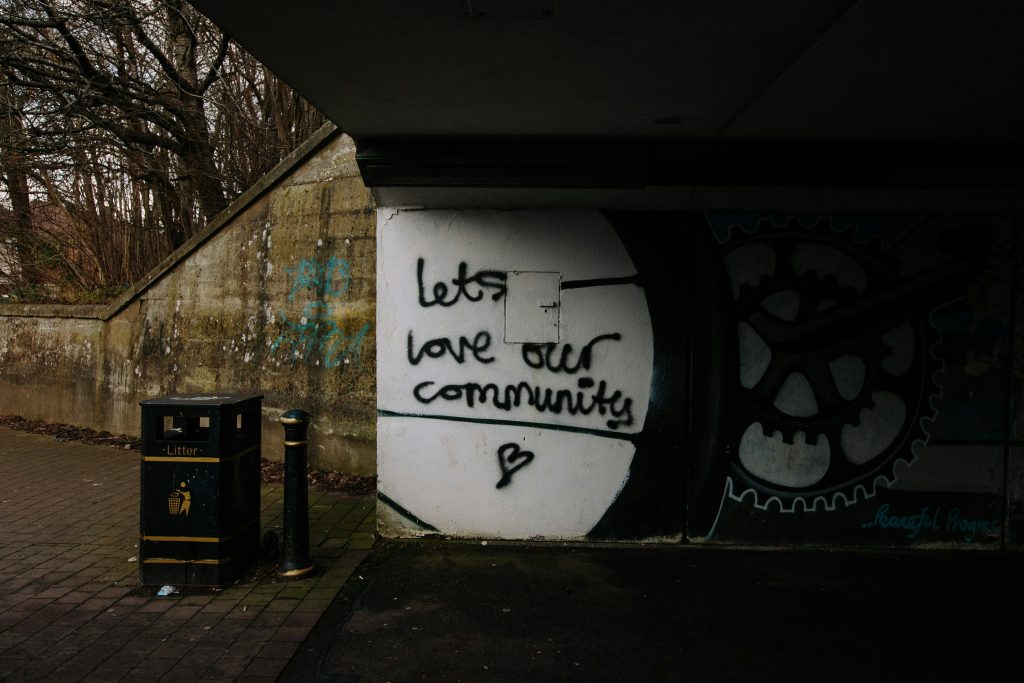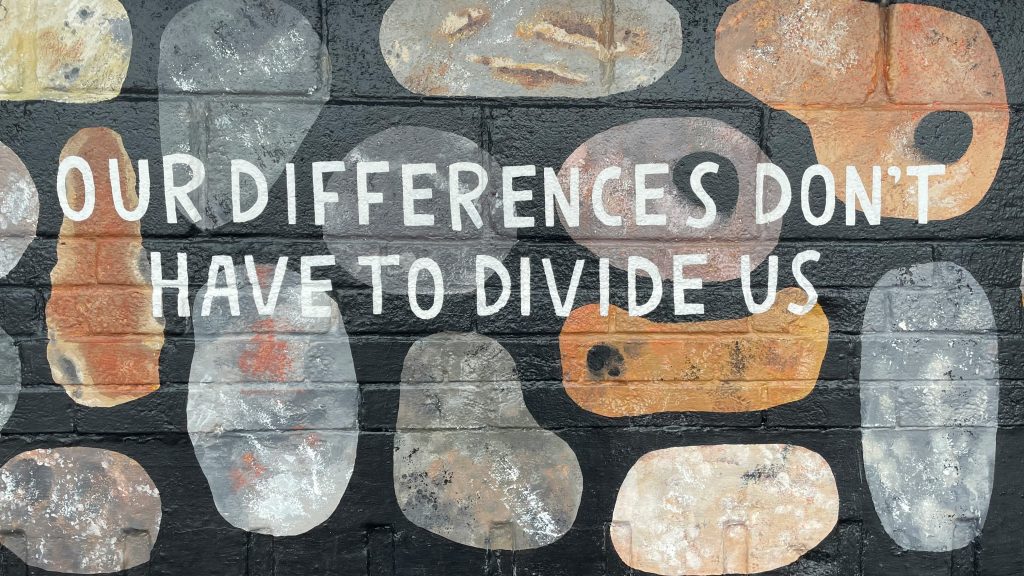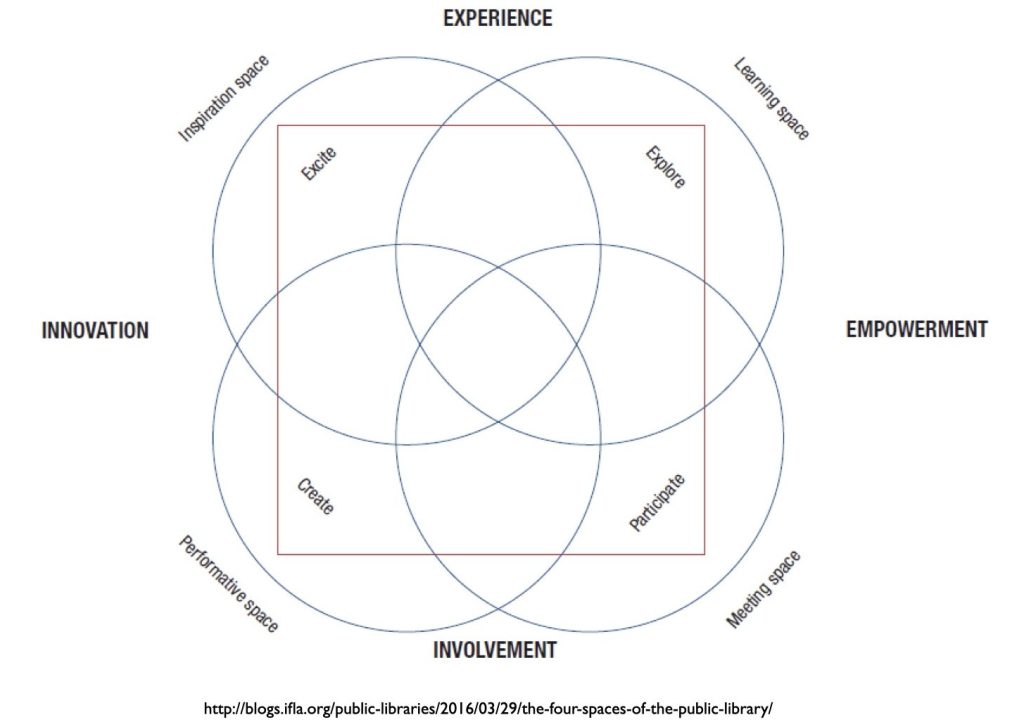Assigment X- Love Always Finds a Way
I am writing this blog as we approach Valentine’s Day, so the idea of love and connection is at the forefront of my mind. I am not talking about the notion of romantic love, but that of universal love that connects humanity.

One of the moments in my life that exemplifies this universal love was when my grandmother came to the United States in the 1990s for a visit and met my mother-in-law for the first time. My Iranian grandmother spoke no English, had eight kids, and was from a more traditional background as a homemaker, and caregiver. My mother-in-law, who is African-American, a lawyer, and a single mom to her four kids, lived a completely different life. When they met, they simply embraced each other. Each speaking in their respective language, they expressed their happiness and love at meeting each other, and welcomed each other with open arms. That moment stuck with me because it showed that connection and love can transcend language and cultural barriers.
Fast forward to 2024, when culture wars took over almost every aspect of society in the United States, including libraries. Librarians are increasingly facing the threat of violence and intimidation from a vocal, misinformed minority. In my hometown of Davis, the local library faced multiple bomb threats and the FBI had to step in to investigate. This was partially due to the amplification of these misinformed voices on social media. As Searles & Weinberger (2015) point out: “Demonization of ‘them’-people with looks, languages, opinions, memberships we don’t understand, like or tolerate-is worse than ever on the internet…. Hatred didn’t call the net into being, but it’s holding the Net and us-back”.
How do we find our way back to creating a true community where people from all walks of life can feel safe to participate fully? How do we amplify the voices of peace and love from the majority who are being shut out by a fearful minority? Or better yet, how do we get that minority to open their hearts up to all and view the “other” through a prism of love, and not fear?

These are profound questions that many grapple with daily. While we have the entire world at our fingertips, we struggle to connect with those different than us, because we are unable to carry on conversations with them. In their 2015 follow-up to Cluetrain Manifesto, Searls and Weinberger state that “Conversation requires a common ground: shared language, interest, norms, understandings. Without these, it’s hard, even impossible to have a conversation”. But the problem is that “shared grounds spawn tribes” and give rise to “us vs. them” (Seale & Weinberger, 2015). To meet this challenge, the net needs to learn from the best of our real-world cultures by being welcoming (Searle & Weinberger, 2015), perhaps emulating the encounter between my grandmother and mother-in-law. While technology makes it possible to connect widely, only empathy, understanding, civility and kindness can make others feel welcome (Stephens, 2016).
Library 2.0 & Facilitating Conversations
How can libraries facilitate respectful, and non-judgemental dialogue between all these “tribes” with the ultimate goal of creating one human tribe? Library 2.0 is well suited to facilitate these conversations. The “evolution of libraries and library service will include a pronounced shift from libraries as book warehouses to libraries as centers for discovery, learning, and creation via any number of platforms” (Stephens, 2016). One way this happens is through the design of library spaces, both physical and virtual, to engage the community. Jakob Laerkes’ (2016) article describes how the future goals of public libraries- experience, involvement, empowerment, and innovation– can be achieved by creating four overlapping spaces. These spaces are not necessarily physical rooms, but can also be virtual spaces. Inspiration spaces provide “meaningful experiences that transform our perception” while learning spaces allow users to learn through “play, artistic activities, courses, and so many other activities”. Meeting spaces provide “platforms where you come across people with different interests and values from your own and encounter opinions that challenge you through discussion and debate”, and performative spaces that can facilitate the creation process through involvement and innovation (Laerkes, 2016).
 At the intersection of empowerment and involvement lies the meeting space. One brilliant example of a meeting space or platform for people to interact with others of different values and interests is the Human Library Project. A human library is where people can borrow human beings as open books (The human library organization, 2020). The users of the library who volunteer as human books are co-creators of content (they actually are “content” of the library). By providing this platform for users to engage with each other, and to learn from one another, the library is exercising “radical trust” and letting go of any control over the actual conversations. Instead, they serve as a safe space and act as facilitators of this much needed dialogue.
At the intersection of empowerment and involvement lies the meeting space. One brilliant example of a meeting space or platform for people to interact with others of different values and interests is the Human Library Project. A human library is where people can borrow human beings as open books (The human library organization, 2020). The users of the library who volunteer as human books are co-creators of content (they actually are “content” of the library). By providing this platform for users to engage with each other, and to learn from one another, the library is exercising “radical trust” and letting go of any control over the actual conversations. Instead, they serve as a safe space and act as facilitators of this much needed dialogue.
“A book with us is a person that volunteered to represent a stigmatized group in the community and based on their personal experiences can answer questions from readers to help challenge what is being said/told/understood about a given topic. To help shed light on the facts as you know them. Books are not political or on a mission when with us, but rather able to surrender to the agenda of the reader and allow them control of the conversation” (The human Library Organization, 2020).
How do we “converse” in a world, where minsinformation is rampant, and we can’t even agree on the basic facts? One solution may be to use fun, interactive and immersive escape rooms in libraries to battle misinformation. The Euphorigen Investigation is “an escape room that immerses players in a world of manipulated media, social media bots, deep fakes and other forms of deception” (OCLC, 2022).The game is available online and in person, and involves teams of 4-6 players who are moderated by a librarian. After the game, there is a debriefing session where librarians and players discuss the game, providing opportunities for peer learning and reflection. Misinformation is a fraught subject, so the fictionalized theme of the game offers an opportunity to have dialogue about this difficult topic. The ultimate goals of the game are to increase awareness of everyone’s vulnerability to sophisticated misinformation technologies, to reflect on cognitive biases such as confirmation bias’ role in social media, and to change people’s attitudes towards problematic information present on social media. These goals are better accomplished through “play”. Escape rooms are an example of a learning space where users learn through “play” and become empowered to distinguish fact from fiction.
Library 2.0 & Community Engagement- “Created by, for and with the users”
Libraries remain among the last few public places where people from all walks of life and from every age, race and socio-economic status come together. This represents an opportunity for the library to “break down barriers” between the groups by providing programming and events that provide community engagement opportunities (O’Brien, 2019). The public’s view of the library is also shifting from the library as a “book warehouse” to the library as the “community center”. A survey from Pew Research Center reveals that 63% of the public consider classes and cultural events provided by the library as “very important” (O’Brien, 2019).
This hunger for connection and community in the public reflects the times we live in. In 2023, the US Surgeon General declared loneliness an epidemic in the US, with approximately half of the adults in US reporting loneliness. The lack of social connection has dire consequences and “can increase the risk for premature death as much as smoking up to 15 cigarettes a day” (OSG, 2023).
Libraries can provide this sense of connection when they serve as community centers. One shining example of the library as a community center is the Dokk1 Library in Arhaus, Denmark. This beautiful waterfront library in Arhaus serves as the “town square” with spaces for performances, meetings, children’s activities, art installations, and general public gatherings (American Libraries Magazine, 2016). It offers up flexible spacing that can be changed and reconfigured for workshops, or events, based on user needs (Designing Libaries, n.d.). It offers learning spaces, meeting spaces, performative spaces and inspiration spaces to inspire, involve and empower the users to become co-creators and co- producers in the library.
Dokk1 begins with the citizen or user as its core concept and focuses on “lifelong learning, diversity and cooperation, broadening experience and cultural awareness, and providing links between individuals and knowledge” (Designing Libraries, n.d.). It accomplishes through user involvement and design thinking, both in the planning and building of the physical space, and in the design and implementation of services (Østergård, 2018). Design thinking is a mindset and practice that focuses on “continuous change through user involvement” (a tenet of library 2.0- continous and purposeful change) and ceding control to the users or the community through partnerships (another principle of library 2.0- radical trust). Marie Østergård (2018), head of community engagement at Dokk1, states that over 120 programs, and events are offered every month and 60% percent of these are implemented by or with partners. The skillset of the partnership organizations makes it possible to create innovative services and programs for the citizens or the community (Østergård , 2018). Dokk1 is in short a “democratic space created by, for and with citizens (iihs channel, 2021).

Library 2.0 and Daring to Dream
One of my long standing dreams has been to create a multicultural center where different aspects of various cultures in the community could be fully explored on a rotating basis. In this dream, the center would focus on the literature, film, art, music, dance and food from one country, culminating with a celebration that would feature music, food and dancing from that community. This would be on-going throughout the year, with different cultures being featured every month. My dream is that these types of events will allow the larger community to fully engage with the “other”, breaking bread with them, and celebrating their culture, and maybe, just maybe, start to see them through a prism of “love”, rather than fear. Metaphorically speaking, this would be equivalent of my mother-in-law and grandmother, two women from two different cultures, finding common ground and embracing each other with love. I never thought I could realize this dream in a library, but the concept of hyperlinked libraries makes me hopeful that it’s possible.
References:
American Libraries Magazine (2016, August 29). Moving Beyond the “Third Place”. Retrieved from: https://americanlibrariesmagazine.org/blogs/the-scoop/library-design-moving-beyond-third-place
Designing Libraries (n. d.). Dokk1: Impressions of an Impressive library. Retrieved from: https://designinglibraries.org.uk/resources/reimagining-the-library/dokk1-impressions-of-an-impressive-library/
iihschannel. (2021, February 26). Virtual Library Walk – DoKK1 Public Library & Cultural Centre, Aarhaus, Denmark [Video]. YouTube. https://www.youtube.com/watch?v=tDCYK3ELf54
Human Library Organization. (2017, April 17). Human Library explained in a minute [Video]. YouTube. https://www.youtube.com/watch?v=fCGBXKy4Wuk
Laerkes, J. G.(2016, March 29). The four spaces of the public library. IFLA Public Libraries Section Blog. https://blogs.ifla.org/public-libraries/2016/03/29/the-four-spaces-of-the-public-library/
O’Brien, C. (2019, June 24). How San Francisco’s public libraries are embracing their changing role. Shareable. https://www.shareable.net/how-san-francisco-public-libraries-are-embracing-their-changing-role/
OCLC. (2022, July 12). The Euphorigen Investigation: Backgrounder. WebJunction. https://www.webjunction.org/news/webjunction/euphorigen-investigation-backgrounder.html
Office of the Surgeon General- OSG (2023). Our epidemic of loneliness and isolation: The U.S. surgeon general’s advisoy on the healing effects of social connection and community. Washington DC. US Department of Health and Human Services. https://www.ncbi.nlm.nih.gov/books/NBK595227/
Østergård, M. (2018). 6. Dokk1 – Re-inventing space praxis: A mash-up Library, a democratic space, a city Lounge or a space for diversity? In D. Koen (Ed.), Library Design for the 21st Century (pp. 91–103). De Gruyter. https://doi.org/10.1515/9783110617535-007
Searls, D. & Weinberger, D. (2015). New Clues— Manifestos for the Information Age: An anthology. (n.d.). https://blog.9while9.com/manifesto-anthology/2015newclues.html
Stephens, M. T. (2016). The heart of librarianship: Attentive, positive, and purposeful change. ALA Editions, an imprint of the American Library Association.
The Human Library Organization (2020, February 27). The Human Library Book FAQ – The Human Library Organization. https://humanlibrary.org/meet-our-human-books/the-human-library-book-faq/
9 Comments
Laura Wecksler
Major applause, @royaflin! Your beautiful, personal story frames your case so well. I ran across the Human Library Org. last semester when researching for an assignment and just loved the idea. The Beatles’ song is in my head now, “all you need is love…” 😁 Well done.
Roya Koutchekinia
Thank you so much, @lauraw. Glad you enjoyed it. All you need is love would have been a great title for this post!
amyb
Well done @royaflin! Your post is thought provoking and inspiring. In our reading I really latched on to Laerkes’ article about the four spaces of the public library. My local library is in desperate need of a redesign and the concept of the four space library model including inspirational, learning, performance, and meeting space really appeals to me. I also LOVE design thinking and Dokk1. I was fortunate to be able to interview Marie Østergård for my INFO 204 Strategic Plan project. I hope to visit one day.
@lauraw thank you for highlighting the post!
Roya Koutchekinia
Thank you so much @amyb ! That is so amazing that you got to interview Marie Østergård. I would love to see that strategic plan. I really want to visit Dokk1 as well. Maybe we should all go on a field trip😀! I hope that your local library has a successful redesign.
Donna
Fantastic post @royaflin! I remember hearing about the human library in a previous class and was happy to hear more about in your post! I especially loved reading about your dream of the multicultural center and the cycling of different aspects of culture- the way you mentioned seeing it through “love” instead of hate reminds me of this quote- “we fear what we do not know”. And being able to learn and know is exactly what we need more of!
Roya Koutchekinia
Thank you so much @donna128! I totally agree that getting to know the “other” can break down barriers. Your reply reminded me of this story where an African American Blues musician convinces 200 klan members to give up their robes. Here is the link to the story if you’re interested https://www.npr.org/2017/08/20/544861933/how-one-man-convinced-200-ku-klux-klan-members-to-give-up-their-robes
Donna
Thanks for sharing the article, @royaflin! Reading Davis’s experience and seeing how he communicated with klan members by finding common ground shows just how far being “armed with knowledge” can go and how important it can be to question idealogies and set beliefs as that can not only open up a brand new pespective, but the doors to a whole new world 🙂
Jeanna
Beautifully put. The lonliness statistics are figuring into my project as well.
The human library project could do amazing things for combating prejudice, one person at a time.
Interesting story: My father, a prison guard, is racist and homophobic to the extreme, but one year when I was a teenager, I had tickets to see “Kiss of the Spider Woman” on tour, and he drew the short straw as my chaperone. He sat in a dark theatre for two hours and watched two mixed-race men fall in love in a prison cell, bringing them comfort in their misery. By the time we were coming home, he was quiet. “I never thought about it like that.”
It didn’t change him permanently, but it did make him think. If one piece of art can do that, what can an actual connection with a real human being do?
Roya Koutchekinia
Hi @jeanna. Thank you so much for sharing the story about your father. It’s a beautiful story and I do agree that personal stories are powerful in opening up people’s minds. My love of literature and film (and stories) stems from the fact that you can know the whole “story” of a person, rather than just the politicial/ideological viewpoint which is what is causing our culture wars. You might also be interested in this story about the African American Blues musician who befriended 200 klans members which led to them giving up their robes- https://www.npr.org/2017/08/20/544861933/how-one-man-convinced-200-ku-klux-klan-members-to-give-up-their-robes